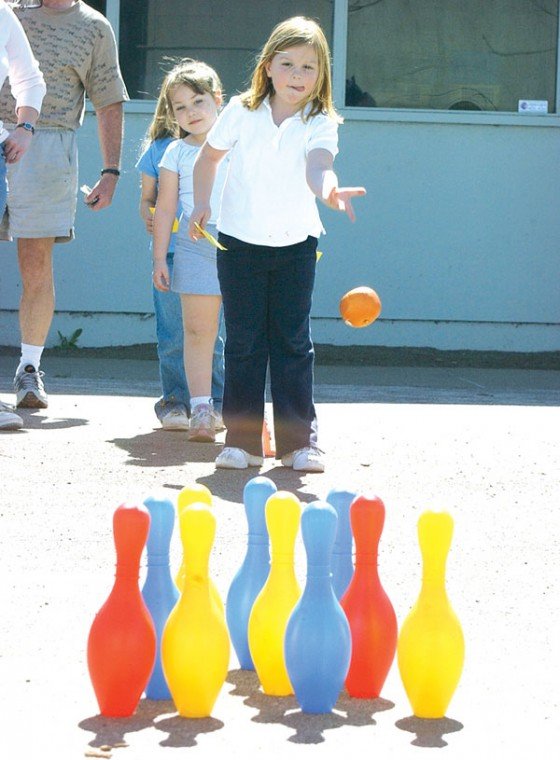GILROY
– Lunch foods spotted on the Rucker Elementary School campus on
a recent sunny afternoon: Raisins, pickles, watermelon and jicama.
Yes, jicama, a tuber with taste and texture that’s somewhere
between a water chestnut and an apple.
GILROY – Lunch foods spotted on the Rucker Elementary School campus on a recent sunny afternoon: Raisins, pickles, watermelon and jicama. Yes, jicama, a tuber with taste and texture that’s somewhere between a water chestnut and an apple.
The students are getting a taste of fruits and veggies from “A to Z” as part of a health and wellness fair that is visiting each of Gilroy Unified School District’s eight elementary schools.
“The concept behind it is that we need to also educate the kids on the importance of fruits and vegetables and to provide that information in a non-traditional, interactive, fun way,” said Lillian Castillo, director of the Gilroy Nutrition Task Force, who helped organize the fair.
Servings of watermelon and honeydew melon shared second-grader Sam Aptkar’s plate with chicken nuggets and tater tots. Aptkar said he enjoys eating fruits and vegetables – especially strawberries, carrots and Chinese chicken salad – but didn’t try any unfamiliar foods from the salad bar.
“They looked gross,” Aptkar said. “What are those red beans?”
Although the fair’s organizers would probably have wanted Aptkar to try the red kidney beans, the idea behind the salad bar was to introduce new fruit and vegetable choices.
“With kids, it takes a while for them to accept a new food,” Castillo said. “If you keep providing it to them in a non-threatening way, they usually will try it and, in many cases, like that new food.”
Watermelon appeared to be the most popular choice from the salad bar among Rucker students, perhaps due to the mid-80 degree temperatures.
Katie Famalett tried the juicy, red fruit for the first time at the lunchtime fair.
“Because it looks good,” the first-grader said, “because it’s my favorite color.”
Castillo recruited school nurses to provide nutrition information to teachers, as well.
“They are worried, they are really worried, about childhood obesity in Gilroy,” Castillo said.
Their worries are reflected across the country. The National Health and Nutrition Examination Survey found that, in 2002, 15.5 percent of children were seriously overweight – triple the amount from 20 years earlier.
The rate in Santa Clara County isn’t any better, according to data from the Childhood Health and Disability Prevention program, which serves 60 percent of county children.
The school-age overall rate of obesity is 20 percent, while the rate in Hispanic children is 25.7 percent. Of students aged 12 to 19 years, the overall obesity rate is 17.7 percent, while the rate for Hispanics is 25.4 percent.
“From talking to people, when they look at Gilroy, this is a big portion of that,” said Dr. Elizabeth Mendoza-Levy, pediatric site director at Valley Health Center in San Martin. “Because we have such a large low-income Hispanic population here, and I can tell you from personal experience here that I deal with this a lot.
“I have children that are 11, 12, 13 years old and are 100 pounds overweight, and it’s really frustrating because there’s so much stuff that they snack on.”
The fair, which has already visited several elementary schools, was created and funded through a partnership involving the Gilroy Nutrition Task Force, the Children’s Health and Fitness Coalition of Santa Clara County, Expanded Food and Nutrition Program, Gilroy Early Learning Initiative, Nutrition Network and GUSD Food Service, which purchased the A to Z fruits and vegetables.
“In any population that consumes at least five servings of fruits and vegetables, you see that there is improved weight management,” Castillo said. “Studies show that, in many, many cases, children drive what the parents purchase. So maybe we can get kids to say, ‘Hey mom and dad, can you buy more fruits and vegetables?’ ”
The fair also featured games involving physical activity to encourage exercise among youngsters. In one game, students tossed heads of cabbage into bowls. Another involved throwing bean bags through holes resembling fruits and vegetables. Scores of students also lined up to spin a wheel containing numerous fruits and veggies and answer related questions.
One example question: “What colors are apples?”
Answer: “Yellow, green and red.”
Students received stamps that could later be traded in for prizes like pencils and erasers.
Physical education instructor Pat Vickroy said that, while the intent of the physical portion of the fair was beneficial, the one-day emphasis will not establish life-long activity habits.
“What they’re trying to do is bring an awareness to schools and people are aware,” Vickroy said. “They have plenty of knowledge to make appropriate decisions to increase activity and to promote health and wellness in schools.”
Vickroy said he would rather see physical activity be included in everyday education and offered to help create active games for next year’s fair.
He criticized the connections that are often drawn between physical activity and improved academic performance.
“Health and physical education stand on their own. There’s not a need to make that link to qualify it to be in our programs,” he said. “Being healthy and physically fit prevents heart disease, and all those other things, so just the academic benefit alone isn’t enough.”













